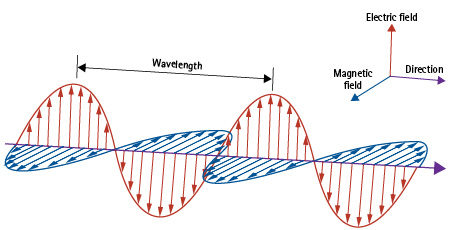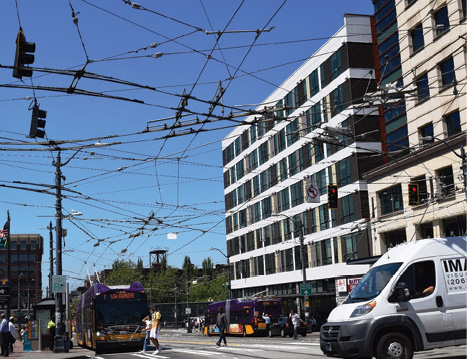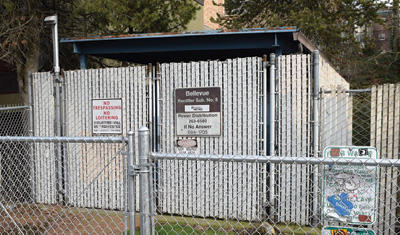
By Chris Greene and Tim Frank
You may not realize it or MAY never have given it a second thought, but if you live in a large metropolitan area, alternating current (AC) and direct current (DC) energy systems are all around you. Although I have studied these two systems for years, I didn’t always know about it. I was caught completely unaware and surrounded by an invisible, lethal hazard. This is my near miss story and the lessons learned.
In the summer of 2011, Seattle (WA) Fire Department Engine Company 25 responded to a report of “wires down” at Broadway and Madison Street, a busy intersection in Seattle’s Capitol Hill neighborhood. It is a wide multilane intersection of five streets with electrical catenary wires for streetcars and electric buses traveling north/south and east/west. More than a thousand pounds of steel wire and hardware keep the system suspended under tension and deliver the current to the electric buses and streetcars through this intersection (photo 1, 2).
Normally, a “wires down” call is for a single line on the ground; but this time, we arrived to find the entire overhead electrical catenary system ripped from its support lines and lying in a heap in the middle of the intersection. The elevated bed of a dump truck traveling through the intersection had pulled it all down. On arrival, I had assumed that the lines were de-energized because of ground contact, but we exercised extreme caution on approach, just in case.
Moments later, a King County Metro Transit (Metro) supervisor arrived on scene and announced, “I’ll get this de-energized immediately.” I thought, “You’ve got to be kidding me! These are energized right now?!” What I didn’t understand at the time was that these lines provided direct current (DC) to the Metro electric buses and were not alternating current (AC) lines similar to other down wire calls to which I had previously responded.

The alternating or back-and-forth movement of the electrons creates a three-dimensional collapsing sine wave, which produces an electromagnetic field that an AC voltage detector can sense. However, because of its unidirectional electron movement, DC does not have this energy field. (Figure courtesy of Chris Greene.)
That the unshielded, 700-volt (V) DC lines remained energized despite clearly being in direct contact with the ground is not unique. The power system interpreted the ground as a normal “load” and the power was not interrupted.
Although this marked my first incident involving DC catenary lines, I quickly realized they were present throughout our city and distinct from AC power lines. A closer look at these two electrical systems reveals just how different they are and how fire department personnel should approach them differently.
The following is a brief overview that will help you better understand how AC and DC work and where you may encounter each.
Direct Current
DC power is uni-directional; it travels only in one direction. A household battery is a small-scale example of DC. The electrons flow from negative to positive until the battery is completely discharged and power is consumed. Historically, elevators have been powered by DC since it allows good speed control and torque, making it preferable for the smooth operation of heavy elevators. However, over the past 25 years, many DC-powered elevators have been converted to AC power. On a much larger scale, DC electricity is commonly used to power trains, buses, trolleys, and other transportation systems using a “third rail” or an overhead catenary wire system.
DC mass transit systems require rectifiers to rectify or convert AC to the DC. Rectifiers can be aboveground or in underground vaults; they will be in a secured area marked “High Voltage.” They must be placed throughout the run of a catenary line since the DC power may need to be boosted, depending on the system’s load—i.e., the number of buses or trains using the line (photo 3).
DC catenary lines may be aboveground or underground. Aboveground catenary systems will be unshielded wire, but belowground lines will likely be wrapped and shielded. Underground DC lines are susceptible to faults and failures that may result in fires, manhole explosions, and so forth. Since our nation’s metropolitan areas depend heavily on mass transit systems, underground DC lines will be a challenge for first responders as these systems age and begin to fail.
When a DC line touches the ground, the line will not necessarily fault and open the circuit, thereby stopping the flow of current to the down line. When this happens, the system interprets the ground contact as additional resistance (load), similar to an electric bus on the line requiring more power to climb a hill. Consequently, the equipment commonly used to determine if there is electrical activity in an area (like an AC voltage detector) may not detect any electrical activity partly because of the lack of an electromagnetic field created by an AC current that is absent with DC (photo 4).

(1) Hazards fill this entire intersection, which is similar to the one described in the down wire incident. (Photos by Chris Greene.)
Alternating Current
AC is bi-directional, traveling in two directions, alternating back and forth, 60 times per second, along the transmission line (Figure 1). AC is the electricity supplied to your home. To provide power to an urban area, the AC electric grid is typically supported by the following:
• Substations of multiple types that convert and distribute the voltage.
• Transmission lines that move voltage greater than 100 kilovolts (kV) over a long distance.
• Transformers that step down (reduce) or step up (increase) voltage.
• Primary or high-voltage lines with capacities generally less than 34kV for city grids.
• Secondary lines that carry less than 600 volts are stepped-down lines that feed smaller transformers.
• Service lines used to bring power from smaller transformers to the public consumption. For residential service, this generally means voltages of 120 and 480 for commercial.
High-voltage overhead transmission lines will generally have capacities greater than 100kV and will be unshielded wire. Overhead primary lines use a pole-mounted step-down transformer to convert the high voltage to a more usable 120V residential secondary feed. Generally, these lines are wrapped and shielded using a material commonly referred to as “tree wrap” that protects the line from faulting against a tree.
Seattle’s key infrastructure areas are supported by an underground high-voltage network system that will provide redundancies to ensure no loss of power to critical loads such as hospitals and other key business areas.
Automatic reclosers are commonly used with overhead primary lines to maintain power in the event of a fault. This feature attempts to clear a fault (making three attempts over five seconds) rather than simply de-energize the line and leave the circuit open. When a fault occurs, the circuit “opens,” which interrupts the flow of energy. The reclosing feature will attempt to reclose the circuit in an attempt to “blow off” the item causing the fault. If it succeeds, the branch or other item will be moved off the line with the energy surge. But if unsuccessful after the three attempts (over five seconds), the circuit will remain open and voltage will be unable to flow through the circuit. An interesting side note is that automatic reclosers have received heavy criticism for potentially exacerbating some of the recent wildland fires in central California.
AC lines are equally common underground and are also subject to line fatigue, faults, and chemical or rodent damage, which can result in manhole fires and lead to explosions under certain conditions.

AC vs. DC: Differences
It is critical to understand the differences between AC and DC voltage. The following may keep you safe on the next “line down” alarm:
• Your stray voltage detector will not detect DC voltage. When AC current alternates, it produces a collapsing sine wave of electromagnetic energy, which is what your stray voltage detector reads; it is not present with DC current. You must understand how to use the electrical detection equipment on your apparatus and its limitations.

• AC and DC down power lines act differently when they contact the ground. AC and DC lines that have made contact with the ground after an incident may see the ground as a “load” and remain energized. A significant difference is that a down AC overhead line will create a ground gradient hazard. Conversely, a down DC line may be energized without the presence of a strong detectable ground gradient voltage field. A ground gradient field generally only occurs when very high voltages are achieved, but in the case of mass transit power lines, this is uncommon. A voltage detector will provide no indication of DC energy on an energized DC line and thus may give a false sense of safety to responders.
• AC and DC hazards often share the same space. Recognize that these hazards can simultaneously be present. Consider a DC rectifying station. My experience has revealed that rectifying stations are always married to AC transformers in one large area. They can be underground or aboveground. In residential neighborhoods, they are often pad mounted; the only indication of their presence may be a six-foot cyclone fence and a sign that says, “Caution High Voltage.” They are much smaller than traditional substations and may be mistaken for benign metal lockers unless you look closely or are familiar with the equipment.

• Identify the responsible party. Many cities delineate the responsible party by what party rectified or transformed the power last. For example, Seattle City Light distributes most of the AC power in the city, whereas King County Metro Transit delivers all rectified DC power used by its mass transportation equipment. Depending on the situation, the party responsible for deenergizing the down line or energy equipment may differ. This can cause confusion and delay capturing definitive information during these incidents.
CHRIS GREENE is a 24-year veteran of the fire service and the captain of Station 25 with the Seattle (WA) Fire Department (SFD), assigned to Engine Company 25, which is part of the Vault Fire Response Group (VFRG). He created the VFRG within the SFD while working closely with Seattle City Light personnel to identify hazard gaps in fire department equipment and response strategies/tactics for electrical emergencies.
TIM FRANK is an 18-year veteran of and a lieutenant with the Seattle (WA) Fire Department, assigned to Ladder Company 10, which is part of the Vault Fire Response Group stationed in the Capitol Hill neighborhood. He also serves as a search manager for the Washington State FEMA Urban Search and Rescue Task Force 1.

